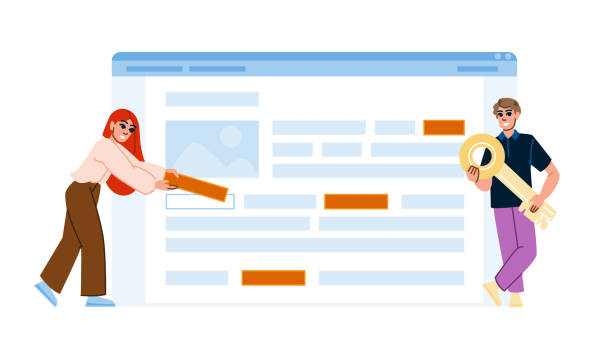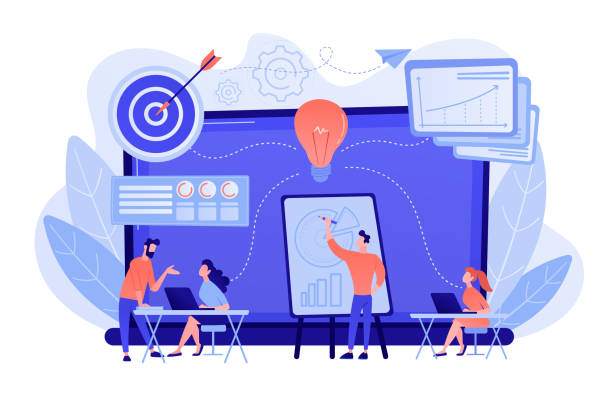The Importance of Multilingual Website Design in Today’s World

In the age of globalization, #business_expansion and reaching new markets have become more important than ever.
One of the most powerful tools to achieve this goal is multilingual website design.
This approach allows you to target #global_audiences and convey your message in their native language.
Suppose you have a business in Iran and want to offer your products or services to customers in Europe, America, or even neighboring countries; without a multilingual website, this would be almost impossible.
Language is the first and most important barrier in international communication, and a monolingual website will close many doors for your business.
Globalization is no longer just a concept; it’s a business reality that requires appropriate tools.
Multilingual website design is not just about translating words; it also involves adapting content to different cultures, which is called localization.
This process goes beyond merely rendering sentences and includes attention to dates, currency, date and time formats, and even colors and images appropriate for each culture.
Your website should be such that users anywhere in the world feel that the content has been prepared for them and in their language and culture.
This sense of belonging and comfort plays a key role in building trust and, ultimately, converting visitors into customers.
This is a strategic investment for the future of any business seeking international growth and development.
Are your online store visitors leaving before making a purchase? Don’t worry anymore! With Rasaweb’s professional online store design services, solve the problem of low visitor-to-customer conversion rates forever!
✅ Significant increase in conversion rate and sales
✅ Unique and engaging user experience
⚡ Contact us now for a free consultation!
Competitive Advantages of a Multilingual Website

Implementing a multilingual website design brings significant competitive advantages to businesses.
The first and most obvious advantage is #increased_market_reach.
By providing content in different languages, you can access a wider segment of the global population that was previously inaccessible due to language barriers.
This directly leads to increased website traffic and, ultimately, growth in sales and revenue.
Another advantage is #improved_international_SEO.
Search engines like Google prefer multilingual websites for display to users in different geographic regions, especially if the site structure is correctly designed with hreflang tags and separate URLs for each language.
This means higher rankings in local search results and attracting more targeted customers.
Furthermore, a multilingual website demonstrates professionalism and attention to customer needs.
This helps in #brand_strengthening and building trust among international audiences.
When customers see that a business has invested in providing services in their native language, they feel more valued and are more likely to become loyal customers.
Ultimately, this strategy helps you surpass your monolingual competitors and gain a stronger position in global markets.
The opportunities for global growth are countless, and multilingual website design is the key to unlocking these doors.
Challenges and Technical Considerations in Multilingual Website Design

Although the benefits of multilingual website design are numerous, this process comes with specific technical and strategic challenges that must be carefully considered.
One of the most important technical decisions is choosing the appropriate URL structure for each language.
This choice impacts SEO and user experience.
There are three main options: #subdomains, #subdirectories, and #country-code_top-level_domains (ccTLDs).
Each has its own advantages and disadvantages that should be selected according to business goals and available resources.
For example, using subdirectories (like yoursite.com/fa and yoursite.com/en) is often recommended for local SEO, while ccTLDs (like yoursite.ir and yoursite.co.uk) create a stronger identity in the respective country.
Below, you will see a comparative table of these structures:
| Feature | Subdirectories | Subdomains | Country-code TLDs (ccTLDs) |
|---|---|---|---|
| URL Example | yoursite.com/fa | fa.yoursite.com | yoursite.ir |
| Impact on Local SEO | Very Good | Good | Excellent |
| Ease of Implementation | Medium | Easy | Difficult (requires purchasing multiple domains) |
| Maintenance | Easy | Medium | Difficult (each domain managed separately) |
| Cost | Low | Low | High (purchasing multiple domains) |
Furthermore, content management for multiple languages requires a powerful Content Management System (CMS) that supports multilingual capabilities.
Ensuring compatibility with Unicode, support for different date and time formats, and compatibility with Right-to-Left (RTL) writing systems like Persian and Arabic are also crucial technical considerations in multilingual website design.
Failure to pay attention to these details can lead to serious problems in content display and user experience.
Choosing the Right Strategy for Multilingual Website Design

After understanding the importance and challenges, the next step in multilingual website design is choosing the right strategy.
This choice should be based on business goals, budget, and target audience.
Is your goal to attract audiences in a specific region, or do you want a widespread presence globally? To begin, you need to evaluate your Content Management System (CMS).
Does your current CMS (such as WordPress, Joomla, Drupal) natively support multilingual capabilities, or do you need specific plugins and modules? Some CMSs offer dedicated platforms for building multilingual sites that simplify the translation and management process.
Another important step is determining the level of localization you need.
Is just text translation sufficient, or do you need to change images, videos, and even navigation structure for each culture? For example, an #e-commerce website might need to support different currencies, local payment methods, and varying tax regulations.
You also need to decide whether you prefer human translation or will use AI-assisted machine translation.
While machine translation is faster and cheaper, the quality and accuracy of human translation are more essential for critical content (like product descriptions, customer service).
The appropriate strategy in multilingual website design also includes search engine optimization (SEO) for each target language, which requires separate keyword research for each language and culture.
Is your online sales not as expected? With Rasaweb, solve the problem of low sales and poor user experience forever!
✅ Increase visitor-to-customer conversion rate
✅ Create an enjoyable user experience and boost customer trust
⚡ Act now to get a free consultation!
Content Translation and Localization Beyond Words

When it comes to multilingual website design, one of the most vital aspects is content translation and localization.
This process goes far beyond simply converting words from one language to another.
Localization means fully adapting content to the culture, values, customs, and even humor of the target audience in each country.
For example, an image that is considered completely normal and even appealing in one culture might be offensive or inappropriate in another.
#Choosing_appropriate_vocabulary, the #correct_tone, and #idiomatic_expressions that are understandable and relevant to locals are key.
A dry, machine translation can not only fail to establish effective communication with the audience but may also harm your brand.
For technical, legal, or medical content, translation accuracy is of particular importance, and any error can have serious consequences.
Therefore, it is recommended to use native translators who are experts in your field, not only fluent in the language but also fully familiar with the culture and specifics of the target market.
Additionally, in the localization process, attention must be paid to currency, date and time formats, phone numbers, and even measurement systems (such as metric versus imperial).
These small details significantly improve the user experience and make users feel that the website is designed for them and their needs.
Ignoring these points can lead to user confusion and reduced conversion rates.
Ultimately, successful localization creates a stronger communication bridge between your business and global customers and is therefore an essential element in successful multilingual website design.
Technical SEO for Multilingual Websites

To ensure your multilingual website is visible in search engines worldwide, Technical SEO is of paramount importance.
Without proper technical optimization, even the best translations might never reach the target audience.
One of the most important tools for multilingual SEO is the correct use of the hreflang tag.
This tag tells search engines which version of a page is appropriate for which language and geographical region.
Incorrect use of hreflang can lead to serious problems in SEO ranking and reduced website visibility.
In addition to hreflang, a logical URL structure for each language (such as using subdirectories or subdomains, as previously mentioned) helps search engines correctly index your multilingual content.
Separate #XML_sitemaps for each language can also help search bots crawl your content better and faster.
Duplicate content is a common problem on multilingual websites that can be managed by correctly implementing canonical tags and using noindex for duplicate pages.
#Page_Load_Speed and responsive design for different devices, especially mobile, are also important across all languages.
International audiences may use internet connections of varying quality, so optimizing images and scripts for faster speed is crucial.
Finally, regularly monitoring SEO performance in tools like Google Search Console for each language version allows you to quickly identify and resolve issues and ensure the success of your multilingual website design.
User Experience (UX) in Multilingual Website Design

User Experience (UX) plays a vital role in multilingual website design and is even more important than correct content translation.
A site with excellent content but poor UX cannot retain users.
One of the fundamental principles is the #Language_Switcher, which should be easily accessible and visible.
This feature is usually placed in the site’s header or footer, allowing users to quickly select their preferred language.
Also, proper fonts and encoding must be ensured to support specific characters of each language (such as Persian and Arabic letters or East Asian characters).
#Responsive_Design is essential for all languages, as users access your website from various devices.
Page layouts should be designed so that they don’t break even with varying text lengths in different languages.
For instance, German texts are typically longer than English texts, and Persian and Arabic texts require Right-to-Left (RTL) direction.
Paying attention to these small details significantly impacts #user_comfort and #their_interaction_with_the_website.
Below is a table of best UX practices for multilingual websites:
| UX Element | Description and Importance | Example |
|---|---|---|
| Language Switcher | Should be in a clear and accessible location (usually header or footer), and language names should be used instead of flags. | “فارسی | English” instead of Iran/US flags |
| RTL/LTR Support | For Right-to-Left languages like Persian and Arabic, the entire page layout must be adjusted from right to left. | Changing text direction, images, navigation |
| Fonts and Typography | Use fonts that support all characters of the target languages and have high readability. | Choosing an appropriate font for Persian (e.g., Iran Sans) |
| Sufficient Space for Text | Allocate space for longer texts in different languages to prevent layout breakage. | Increasing padding or margin in buttons and boxes |
| Localized Content | Beyond text translation, images, videos, and even form error messages should be localized. | Local images, local currencies |
Furthermore, in the user experience design process, cultural details must also be considered.
For example, colors, symbols, and even numerical formats have different meanings in different cultures.
A successful multilingual website design not only changes the language but also optimizes the entire experience for each international audience, making them feel at home.
Maintenance and Updating of a Multilingual Website

After implementation and launch, multilingual website design requires continuous maintenance and updates.
This phase is often overlooked but is crucial for maintaining the website’s effectiveness over time.
Content in all languages must be up-to-date, and any changes in products, services, or company policies must be applied simultaneously across all language versions.
Lack of coordination in content updates can lead to user confusion and loss of trust.
Website maintenance includes regularly checking for broken links, fixing potential bugs, and ensuring all forms and buttons function correctly in all languages.
Additionally, #SEO_performance_analysis for each language version should be periodically conducted to ensure optimal ranking in search engines.
Web analytics tools like Google Analytics can provide valuable information about user behavior in each language, helping you optimize your content and marketing strategies.
Multilingual Content Management Systems (CMS) offer features to facilitate these processes, but even with the best tools, there is a need for a team or individual responsible for content management and ensuring its accuracy and up-to-dateness in all languages.
Multilingual website design is a long-term investment, and proper maintenance ensures its return.
Worried about losing customers because you don’t have a professional online store?
With online store design by Rasaweb, forget these worries!
✅ Significant increase in sales and visitor-to-customer conversion rate
✅ Professional and user-friendly design that builds customer trust
⚡ Get a free consultation from Rasaweb
Common Mistakes in Multilingual Website Design and Solutions to Avoid Them

Despite all the advantages of multilingual website design, many businesses make mistakes during its implementation that can harm the site’s credibility and performance.
One of the most common mistakes is #solely_relying_on_machine_translation for all content.
While tools like Google Translate are useful for general content understanding, they are by no means a substitute for human translators for professional and localized translation.
Machine-translated content often lacks the tone, accuracy, and cultural nuances that can lead to misunderstandings or even offense to the audience.
Another mistake is #ignoring_international_SEO.
Simply translating pages is not enough; keywords for each language must be researched separately, and hreflang tags must be implemented correctly.
A website that is not technically optimized for multilingual SEO will never be seen in search engines.
Also, some sites have a hidden or inaccessible language switcher, which makes it difficult for users to find.
This harms the user experience and can lead to site abandonment.
#Incomplete_localization of content, including images, date and time formats, and currency units, is also a common error.
These issues make users feel alienated and reduce their trust.
For example, have you ever encountered a site that displays product prices only in dollars while you are in Europe? This is an unpleasant experience.
To avoid these mistakes, it is recommended to seek help from localization and multilingual SEO specialists and always collect and analyze feedback from your international users.
A successful multilingual website design is the result of meticulous planning and attention to detail.
The Future of Multilingual Websites and New Trends

With continuous advancements in #technology and #artificial_intelligence, the future of multilingual website design will also undergo new changes and trends.
One of the most important upcoming trends is the continuous development and improvement of AI-powered machine translation tools that can produce much more accurate and natural translations.
These tools can accelerate the initial translation process and reduce costs, although there will still be a need for review and editing by human translators to ensure quality and complete localization.
Also, #content_personalization based on the user’s language and geographical location will become a key trend.
This means that websites will not only provide content in the user’s language but also offer a completely customized experience based on their cultural and behavioral preferences.
For example, displaying specific products or services that are more appealing to a particular geographical region.
Multilingual #voice_search is also growing, and websites need to be optimized to respond to these types of searches in different languages.
This includes voice keyword research and optimization for conversational queries.
The increased use of Virtual Reality (VR) and Augmented Reality (AR) on websites also provides new opportunities for delivering interactive and multilingual experiences.
Ultimately, multilingual website design will move towards more integrated and intelligent platforms that simplify content management, SEO, and user experience on a global scale, allowing businesses to operate more effectively in international markets.
Frequently Asked Questions
| Question | Answer |
|---|---|
| What is multilingual website design? | It is the design of a website whose content is available to users in several different languages, allowing users to choose their preferred language. |
| Why is a multilingual website important? | To access international audiences, increase website traffic, improve user experience for non-Persian speaking visitors, and expand business into global markets. |
| What are the benefits of having a multilingual website? | Increased international SEO, attracting new customers from different countries, boosting business credibility and professionalism, and reducing bounce rates by providing understandable content. |
| What are the methods for implementing a multilingual website? | Using subdirectories (e.g., example.com/en/), subdomains (e.g., en.example.com), or separate country-code top-level domains (e.g., example.com and example.de). |
| Which URL structure is best for international SEO? | Subdirectories (e.g., example.com/en/) are often preferred for SEO due to consolidating the main domain’s authority, although each method has its pros and cons. |
| How does a multilingual website affect SEO? | By providing content in different languages, the site appears in local search results for those languages, increasing click-through rates and traffic, and improving the overall domain authority. Correct use of hreflang tags is crucial. |
| How is content translation managed? | You can use professional translators, machine translation tools (with human editing), or Content Management Systems (CMS) with built-in multilingual capabilities or relevant plugins. |
| What are the common challenges in multilingual website design? | Managing translated content, maintaining design consistency across different languages, compatibility with Right-to-Left (RTL) languages like Persian and Arabic, optimizing SEO for each language, and choosing the appropriate URL structure. |
| How do I manage text direction (LTR/RTL) on a multilingual site? | For Right-to-Left languages (like Persian), you need to apply specific CSS styles to change text direction, element arrangement, and table direction. This often involves using the `direction: rtl;` property and other related settings. |
| How can users change the website language? | Typically by using a button, dropdown menu, or language switcher widget prominently placed in the site’s header or footer. Automatic detection of the user’s browser language and suggesting a language change is also common. |
And other services of Rasaweb Advertising Agency in the field of advertising
Smart Marketing Automation: An effective tool for user engagement with precise audience targeting.
Smart Link Building: A professional solution for analyzing customer behavior, focusing on using real data.
Smart Customer Journey Map: A fast and efficient solution for campaign management, focusing on custom programming.
Smart Sales Automation: A fast and efficient solution for user engagement, focusing on attractive user interface design.
Smart SEO: A specialized service for improving SEO ranking based on marketing automation.
And over a hundred other services in the field of internet advertising, advertising consultation, and organizational solutions
Internet Advertising | Advertising Strategy | Advertorials
Resources
Benefits of Multilingual Website Design Multilingual Website Design Services Online Business Development SEO for Multilingual Sites
? Are you ready for your business to leap forward in the digital world? Rasaweb Afarin Digital Marketing Agency, specializing in SEO, content marketing, and responsive website design, is with you to reach the peak.
📍 Tehran, Mirdamad Street, next to Bank Markazi, Southern Kazeroon Alley, Ramin Alley, Plaque 6


